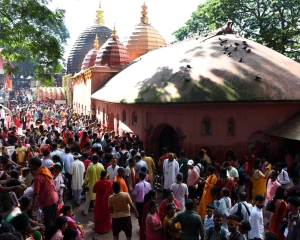Ranakpur is a place that reveals itself slowly, as if testing whether you’re ready to see it. As the train halts at Falna, and the road begins to rise towards the hills, the noise of the world starts to fade. You look out the window, fields stretch flat at first, then give way to forests, ochre ridges, and occasional temple spires that catch the light. This is not a journey measured in hours. It is felt in pauses, glances and stillness. Located in the Aravalli hills of Rajasthan, Ranakpur holds its own presence. Life here moves with purpose, without urgency.
Where Marble Tells a Story
The Jain Temple, built in the 15th century, rises through detail. From the outside, it resembles a stone garden, layered, measured. Once inside, it shifts, becoming a forest of pillars, each carved differently. Light enters through carved windows and dances across the floor. Calm fills the space. You feel invited.
Every surface has been touched by a hand, shaped by tools guided by skill and belief. There are carvings of gods, dancers, vines and stories that spiral upward across the domes.
The centre of the temple holds attention. Time is measured here by movement of light and feet, by the way heads tilt upward when people forget their cameras and simply look.
Outside the Temple Walls
Step beyond the temple, and Ranakpur continues. It is a living landscape. Hills curve in the distance. Streams appear after turns in the road. Banyan trees spread their roots into stone. Monkeys move through branches like wind.
And in quiet moments, you may spot a lone deer or the flash of a peacock crossing a village path. The nearby forest area offers walking trails once used by traders and monks. Nothing here is staged. Yet every stone has history beneath it, every path leads to a story someone remembers. Small shrines, some forgotten by guidebooks, appear without announcement. A walk becomes a meditation. In the nearby town, life continues at its own pace. You see potters shaping clay, women drying red chillies on rooftops, children chasing tyres across open ground. Local food stalls serve hot kachoris and jaggery-sweetened tea. You sit, not for the taste, but to stay a little longer.
A Place That Respects Time
There’s something about Ranakpur that slows thought. Maybe it’s the absence of noise. Maybe it’s the way the mountains curve like a protective hand. Temples stand without barriers. Paths wind without interruption. You hear the sound of dry leaves under foot, the steady turning of prayer beads, the simple flow of a hand sweeping stone steps. In the evenings, the sky shifts into warm gold and birds return to the trees. You watch villagers carry water pots over shoulders, their outlines lit by the last light. No one hurries. You realise you haven’t either.
A Paradise Preserved
To call Ranakpur peaceful is not enough. It is precise. What remains here is presence. The hills have seen kingdoms rise and vanish, yet their contours remain unchanged. Nature, architecture, belief, coexist here without tension. This is a place where you feel small in the best way possible.
You return not with a checklist of sights, but with a shift in pace, a quieter breath, a clearer sense of space. You don’t remember your trip by date or distance. You remember it by light falling on carved stone, by the silence between temple bells, by the way the road looked when it turned one last time toward the station. What if the journey is about reaching a place and discovering how a destination like Ranakpur leaves its mark on you?
Locals and Daily Life
The villagers of Ranakpur often double up as caretakers, storytellers and guides. Most speak a mix of Hindi and Mewari. A few understand Gujarati. English is heard rarely, but hands and eyes bridge that gap. During the off-season, which stretches from May to early July, the crowd thins. You see the temple stand quieter and the local boys play cricket near the steps without being told to stop.
Getting There: KEY TRAIN ROUTES AND City Connections
Ranakpur is not served by an airport or major highways. The journey involves a train to Falna and a quiet road into the hills, perfect for those seeking distance from noise.
- From Delhi, the Ashram Express and Bhuj Express reach Falna overnight.
- From Mumbai, the Aravali Express traces a scenic path across western India.
- From Ahmedabad, Vadodara, Surat, Pune, Bangalore, and Chennai, regular trains connect to Falna.
- Falna to Ranakpur is approximately a one-hour drive by taxi or private car. Local buses also run, though less frequently.
Ranakpur stays quiet. It welcomes slowly, through cool marble floors, winding village roads, and soft-spoken locals. As one of Rajasthan’s lesser-known places, it lets you explore at your own pace whether it’s sitting by the river, walking to the nearby Sadri town or watching the hills change colour at sunset. You leave with photos maybe a morning memory or a name someone told you to remember. And that stays with you.


























